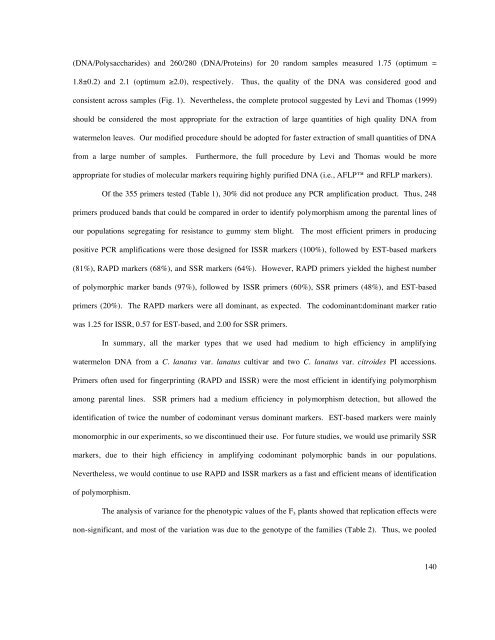Citrullus lanatus (Thunb.) Matsum. & Nakai - Cucurbit Breeding ...
Citrullus lanatus (Thunb.) Matsum. & Nakai - Cucurbit Breeding ...
Citrullus lanatus (Thunb.) Matsum. & Nakai - Cucurbit Breeding ...
Create successful ePaper yourself
Turn your PDF publications into a flip-book with our unique Google optimized e-Paper software.
(DNA/Polysaccharides) and 260/280 (DNA/Proteins) for 20 random samples measured 1.75 (optimum =<br />
1.8±0.2) and 2.1 (optimum ≥2.0), respectively. Thus, the quality of the DNA was considered good and<br />
consistent across samples (Fig. 1). Nevertheless, the complete protocol suggested by Levi and Thomas (1999)<br />
should be considered the most appropriate for the extraction of large quantities of high quality DNA from<br />
watermelon leaves. Our modified procedure should be adopted for faster extraction of small quantities of DNA<br />
from a large number of samples. Furthermore, the full procedure by Levi and Thomas would be more<br />
appropriate for studies of molecular markers requiring highly purified DNA (i.e., AFLP and RFLP markers).<br />
Of the 355 primers tested (Table 1), 30% did not produce any PCR amplification product. Thus, 248<br />
primers produced bands that could be compared in order to identify polymorphism among the parental lines of<br />
our populations segregating for resistance to gummy stem blight. The most efficient primers in producing<br />
positive PCR amplifications were those designed for ISSR markers (100%), followed by EST-based markers<br />
(81%), RAPD markers (68%), and SSR markers (64%). However, RAPD primers yielded the highest number<br />
of polymorphic marker bands (97%), followed by ISSR primers (60%), SSR primers (48%), and EST-based<br />
primers (20%). The RAPD markers were all dominant, as expected. The codominant:dominant marker ratio<br />
was 1.25 for ISSR, 0.57 for EST-based, and 2.00 for SSR primers.<br />
In summary, all the marker types that we used had medium to high efficiency in amplifying<br />
watermelon DNA from a C. <strong>lanatus</strong> var. <strong>lanatus</strong> cultivar and two C. <strong>lanatus</strong> var. citroides PI accessions.<br />
Primers often used for fingerprinting (RAPD and ISSR) were the most efficient in identifying polymorphism<br />
among parental lines. SSR primers had a medium efficiency in polymorphism detection, but allowed the<br />
identification of twice the number of codominant versus dominant markers. EST-based markers were mainly<br />
monomorphic in our experiments, so we discontinued their use. For future studies, we would use primarily SSR<br />
markers, due to their high efficiency in amplifying codominant polymorphic bands in our populations.<br />
Nevertheless, we would continue to use RAPD and ISSR markers as a fast and efficient means of identification<br />
of polymorphism.<br />
The analysis of variance for the phenotypic values of the F 3 plants showed that replication effects were<br />
non-significant, and most of the variation was due to the genotype of the families (Table 2). Thus, we pooled<br />
140
















